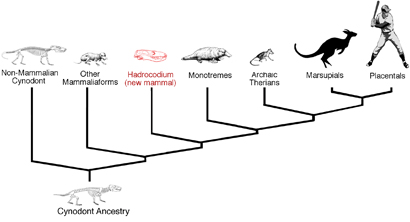There’s a debate going on at Adam Greenfield’s V-2.org (and elsewhere) over Bruce Sterling’s neologism “spime”, a term he coined at Etech 2006 to refer to new technological/networked objects that emerge into human consciousness without a name or an apparent history.

In 2001 a new mammal was found in China. This cladogram shows where scientists eventually classified it and how they named it.
Adam suggests an alternative, “onto”, meaning “an individual networked object endowed with the power of self- description”, and “ontome” for the totality of all those objects (like what a genome is to a single gene).
This got me thinking about the word “taxonomy”, derived from the Greek “taxo”, meaning to order. In a taxonomic system consisting branches and nodes, a “taxon” is a single node. So “onto” should probably be “onton” (which also alleviates the unfortunate fact that “onto” is an English homonym).
But then I thought about the original purpose of taxonomies: to classify animals. That’s kind of like what we’re trying to do here: to classify things, to give names to strange new nameless things. More specifically, Bruce seems to be trying to come up with a name for a general type of thing without a name.

Before we arrived at the Linnean system of classifying life, and eventually to today’s purely evolution-based “Tree of Life” structures known as cladograms, and there were many wildly different systems of classifying animals. If I recall correctly, Aristotle (a Greek!) actually had a system in which animals were divided into groups based on whether or not they were found on his property, or whether or not he found them delicious to eat!
It seems to me that we are currently floundering around in a similar situation to those pre-Linnaeus natural philosophers, naming objects with a lack of understanding of their origin and descent. Even though we may be as intimately familiar with these objects as Aristotle was with the geese in his pond and the rabbits in his woods, we aren’t yet able to see them as part of a continuity of object evolution. Conversely, some of these objects may be like the blind fish at the bottom of the ocean or the microbes living under a thousand feet of rock, unknown to humans until intrepid explorers dive deep, examine them, and name them.
I propose that the generic name for such objects should imply that relationships exist between these objects, but without having to specify those relationships, at least not initially. But unlike Bruce’s axes of space and time, I think we should sort these object based on their provenance or descent, in much the same way different species are connected in a cladogram or the way relatives are connected in a family tree. And unlike with Adam’s “onto”, I don’t think we need to get metaphysical or existential about this, either.
When new technologies and cultural behaviors emerge, trendspotters often say they observed the phenomenon “in the wild”. See where I’m going with this? I think the closest analog to a seemingly new object of unknown origin is a “species“.
This analogy fits nicely with everyone’s apparent desire to connect technology and culture with biology (see meme, or see Adam’s desire to make a connection with genome). But we’re not talking about a blip in a genetic soup, we’re talking about larger-scale full-fledged objects that emerge from the ether of potential objects to become individual new object types — that is, they speciate.
Frankly, I’m satisfied with using the species analogy as a straightforward metaphor, referring to new objects as a “new species”, and then naming that particular. I see no need to create a neologism. If we must get cute, how about a nice word like “critter”, which has that “whatchamacallit” quality of referring to something right in front of you but whose name is not yet known.
Sterling defines spimes this way:
Spimes are manufactured objects whose informational support is so overwhelmingly extensive and rich that they are regarded as material instantiations of an immaterial system. Spimes begin and end as data. They’re virtual objects first and actual objects second.
Whether you think plants and animals are manifestations of genetic code, incarnations of metaphysical archetypes, or creations of a supernatural being, I think seeing new technological/conceptual objects as “species” works perfectly.
Comments
2 responses to “A Spime is a Species”
Ahh, nice. But what onto was explicitly intended to provide was a singular noun: an onto, some ontos, all members of the ontome. I thought it was really important to be able to rapidly distinguish a single networked and self-describing object from the field or set created by all such objects.
How would species work in this context? A specie?
I’m glad, anyway, to have people actively tinkering with words for these important theory objects. Far, far better that people argue about what to call them and settle on something after some consideration than that they merely sit there and get told, “Hey, these things are called ‘spime’” (or “ontos” for that matter).
“Species” is singular, too, like “sheep”. It’s awkward even when not used metaphorically! I guess a single instance of an object type would be an “organism”, all of that type of object is the “species”, and the whole of all species is “life”.
It’s kinda like these objects are really going to be symbiotic/benevolent artificial life forms. Which, of course, is what our future robot masters want us to believe they are.